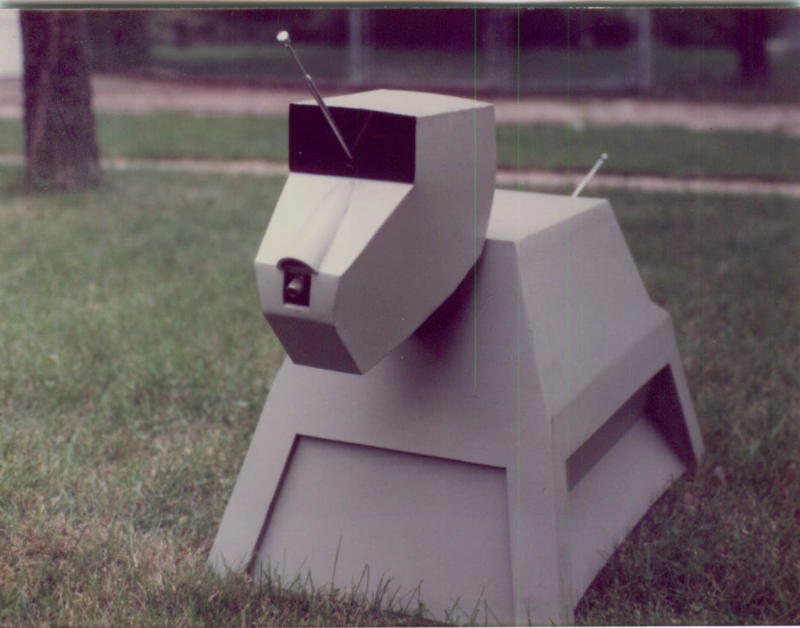
Come out and see my Doctor Who K-9 robot dog
click here to see future events
Resurrecting K-9
I built him over 30 years ago
April 13, 2015
So I was digging through our garden shed a few days ago. I noticed my old K-9 sitting on the shelf looking banged up and pitiful with a broken neck. The "K" has fallen off. Other battle scars were visible from several moves and my wife hitting him with her car in our garage. I built him in 1982 while I was going to college.

Just a puppy. K-9 before his ears, speaker and suction cup. No handle below the head either. This picture is from 1981 or 1982.
The last time that I payed any attention to K-9 was when we moved to our current house in 2003. At that time, I tried hooking up a few batteries from an old UPS to show him to my daughter. We turned on the switch and nothing happened. I put K-9 on the back of the shelf behind the Christmas decorations and haven't touched him since.
Now it's 2015. I decided it's time to dust him off again. First I wiped off the body and set it on my work bench.
I reached in to the front of the head with a small wrench and removed 2 nuts. One held the broken power antenna, the other held the head to a twisted piece of threaded rod. I found the missing nose-blaster loose inside of his head. (The nose blaster was a drill chuck from a Polish-made kids toolset). I also disconnected the antenna motor that was hanging by its' wires inside the body.
Flipping the body on it's side revealed the internal components look to be in good shape. The main board is a VIC20 with the case and keyboard removed. An expansion board has a 16K memory cartridge and an 4K ROM board plugged in. The brown box contains a "Chatterbox" SX-01 based speech synthesizer kit. A breadboard holds some relay drivers and other circuitry. You can also see two solenoids for wagging the tail. Back when I started this project, I bought the VIC20 for $20 on clearance (open box, probably in early 1984).
This time I was more determined to bring K-9 back to life. Using a digital meter, I traced the power leads from the VIC20 back to the Molex connector. I connected a Molex jack to a 5 volt power supply. I plugged it in, held my breath and hit the power switch. Sure enough, after about 7 seconds of silence, I heard a loud monotone voice say "MASTER".
Success!
Click here to hear K-9's first word in 20 years.
Chatterbox Voice Synthesizer that I originally bought for the Sinclair ZX-81
Rather than update K-9 with new technology, I will try to keep this a restoration. Maybe someday K-9 will trolley around again like he did in the 1980's.
Here is the keypad harvested from a 1976 TI-5050 calculator that I used to program and/or drive K-9.
Now it's time to re-learn how to enter the commands listed here in my old K-9 user manual.
5/6/2015
The power antenna was broken in three places
The first break is in the white plastic cord that rolls up. The cord is crimped into a brass coupling.
I drilled the crimps and remove the short white plastic cord, then inserted the remaining cord from the motor assembly. I used a punch to re-crimp it.
The second break is in the black tube. I had this yellowish parts container tube that fits snuggly over the black tube. A few drops of model glue to make it permanent.
The third break is where the black tube attaches to the motor assembly.
Some hose clamps and a block of wood did the trick.
K-9's Eye Lens
I was never really satisfied with the red Plexiglas lens. I cut it by hand, probably with a hacksaw. It's smooth and missing the distinct grooves. I actually had a piece of notebook paper behind it so the lines would show through.
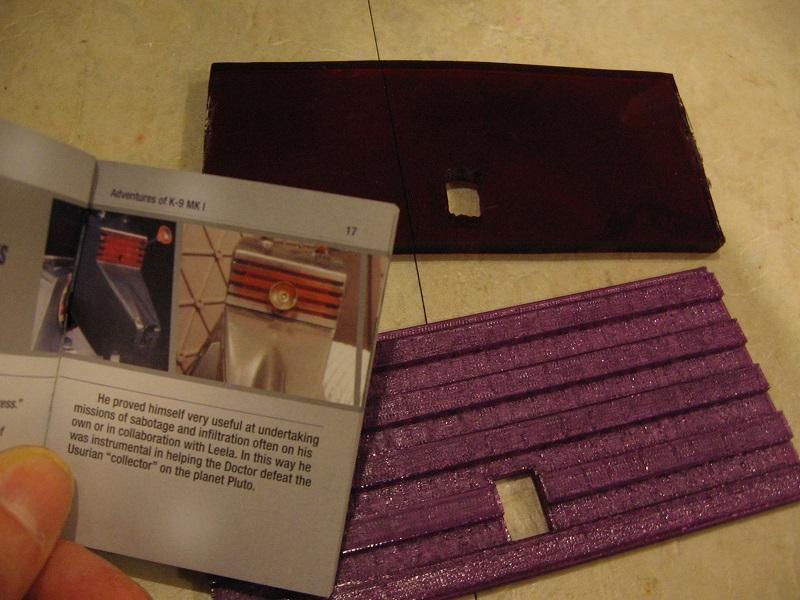
I tried finding someone to mill the original lens, no luck. Our library has a 3D printer. Using tinkercad online, it took about fifteen minutes to learn the program and enter the project. The library had translucent purple filament, no red. Red bulbs pass the red color through it nicely. Cost was only $3.50!
5/30/2015
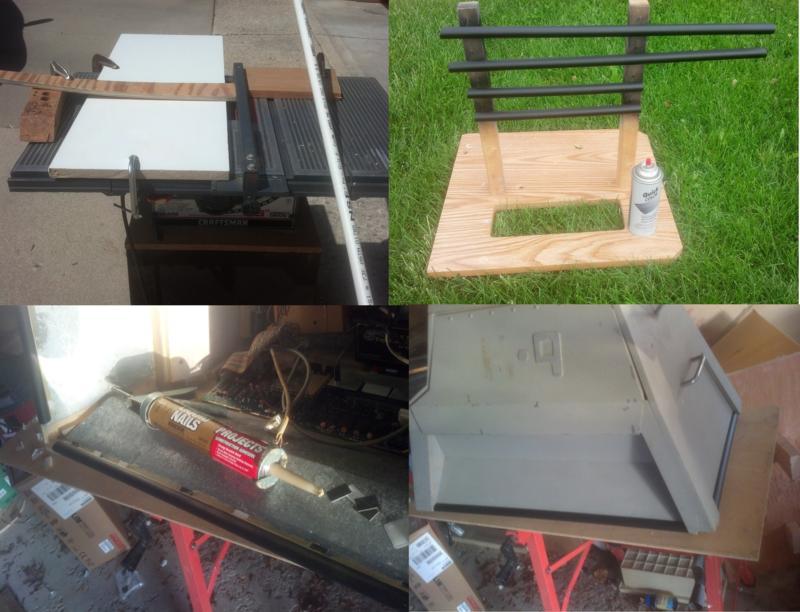
I remember many bloody fingers from the sharp sheet metal around the bottom. I had tried rubber tubing and foam pipe insulation. It wouldn't look right and always fell off. This time I used 1/2 inch PVC pipe to make the bumpers around the bottom. Sawed a slot with my table saw, some black spray paint, shims cut from peel and stick vinyl tiles and some Liquid Nails to hold it all in place.
I have the bends in the head mostly sorted out. The seams in the rear of the head were coming apart, so I used some Liquid Nails on the inside.
I took apart the 6 volt type 47 bulbs and soldered a bright red LED and resistor in to both of them. Bulb consumes 150 mA and LED uses only 20 mA.
6/4/2015
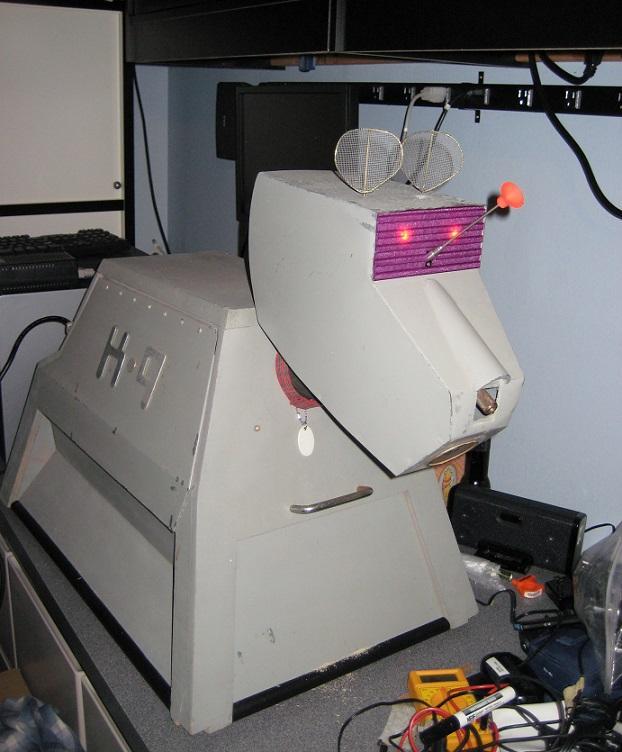
The head is now reattached. "K" is glued in place, new tartan dog collar sewed and installed, nose blaster re-glued and the antenna is lined up with the lens. Lookin' good now.
Click here to hear K-9's Speech Demo (about a minute long description of the robot's features, spoken in glorious vintage phoneme based synthetic speech!)
Next fix tail wagging solenoids.
6/7/2015
Now that the body is cleaned up, we'll take a look at the base. Removed spider webs and layers of crud. Dumped the old batteries.
First thing to do is seal the old flaky particle board. I mixed some water and PVA glue and painted it on the exposed wood. Two coats and it was still kind of rough. So, I put on a coat of Mod Podge. Now it has a nice smooth, almost rubbery coating.
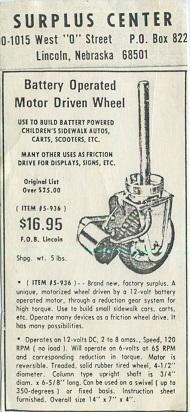
I bought K-9's drive wheel from an ad in Popular Mechanics after seeing Star Wars. I went to order a second wheel to build R2D2, but they were out of stock permanently. A strong wheel, we used it to make a little ride-on cart for a short time. The steering motor was a windshield wiper motor from an old GM car.
The bottom circuit board has some 7400 series logic gates, relay driver chips, LM309K 5 volt regulator and relays. Connections are mostly wire-wrapped under the board.
With the base propped up on a juice can and my Dalek batteries connected, I was able to operate both motors with an old Atari joystick.
"No, it can't shift gears!"
The steering position is sensed by 3 microswitches detecting a bump on the shaft. The "bump" fell off. This is kind of touchy and hard to adjust. I ordered some reed switches to improve it.
The reed switches arrived. Out of the ten switches, three were bad and I cracked two.
The steering motor turned too fast, So I ordered and installed a cheap PWM speed control to slow it down. I just noticed that there are no decoupling capacitors on my TTL chips, oops. TTL gate chatter combined with the steering speed may have been a problem. I just soldered some caps across each chip.
7/29/2015
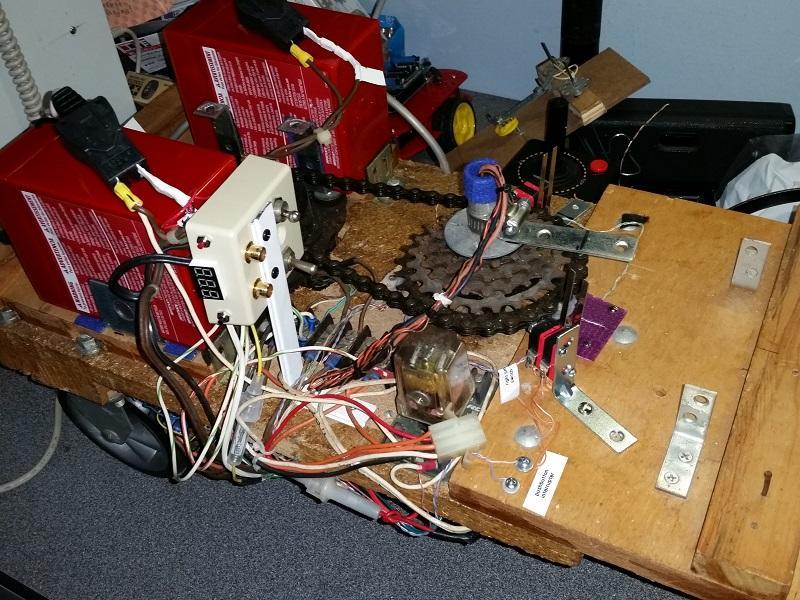
The base is ready to go. Wiring is cleaned up a bit. RCA jacks are to connect charger, digital volt meter to check levels. For steering, I ended up using bigger microswitches and a reed switch to detect center. The base now drives with a joystick.
8/2/2015
The Computer Died!
K-9 no longer says Master when I power him up. I think its the VIC20.
8/8/2015
I just received a a replacement copy of the VIC-20 Programmer's Reference Guide. The schematic is still intact. I relied heavily on this book while designing K-9.
8/10/2015
Today I received a VIC-20 like new in the box (EBAY less than $40 including shipping). I had to fix a broken ground wire in the rf modulator box, also drilled holes in rf box and added RCA jacks for video and audio out.
New VIC-20 works great...but when I plug in the speech box, I get same scary sound.
The outlook is grim now. Just what is an SX01-8(28 pins) voice chip? It's not the Votrax SC-01a(22 pins). The label is hand written. Original print was sanded off the chip. The "Chatterbox" speech kit was a british import set up for the Sinclair ZX-81. I hotwired it for the VIC-20.
K-9's code only output was the voice. I didn't program any video output. Portable video wasn't an option back then, so I can't do much with no feeback.
I only have a hardcopy of the source code. I assembled the code on Xerox 820 CPM machine. My dad donated the computer along with my 8 inch floppies to the local high school years ago. I'm not typing it in and re-learning 6502 assembler at this point.
8/13/2015
Things are looking up again! I searched around and compared a bunch of datasheets. From what I see, the GI SP0256-AL2 matches the SX01-08.
I have a few SP0256-017 chips, but the 017 only talks numbers and clock phrases. So, I found and ordered one from Ebay for $12.50 from California...can't wait for China this time.
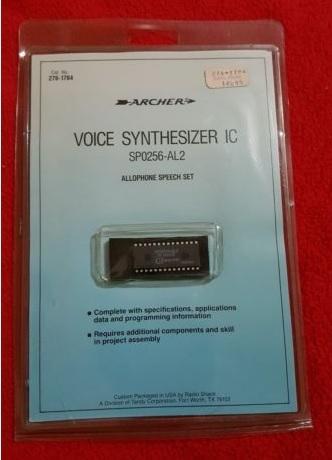
8/17/2015
I don't have much free time (or money) to spend on this project. The voice chip arrived and I still get the same sound. I am beginning to think that the EPROM may have gone bad.
In K-9, the VIC-20 keyboard is removed and the sound board is plugged into the keyboard port with a ribbon cable. The keyboard's 6522 was reprogrammed to service the voice board.
I think the pulses I'm hearing may be keyboard scans. Also, when I boot the VIC-20 with the ROM board plugged in, I am getting READY screen. It should boot from the EPROM and show a blank screen.
I don't have a ROM reader/burner to test read the 2732 on. I do have the old VIC-20 "PROM QUEEN", but that's probably too much trouble.
8/18/2015
So, during my lunch break today, I dug through the garage and found my old PROM QUEEN burner and booted it up to check to ROM.
The EPROM (or at least the fisrt hundred bytes or so) seems to match the hardcopy except for the first 9 bytes. The hardcopy is probably a different revision (41 pages printed on a Diablo daisywheel).
The ROM code starts with A009 which is the first byte on the program, probably intentional. The printout just has FF's. I don't remember why. Maybe someone out there knows how the code on a cartridge should look?
With K-9 being stored in sheds and garages for many years, it's possible that connectors or sockets may have corroded or loosened up. On Monday, I'll try swapping the ROM board with this one from my junk box and see if it boots.
8/19/2015
Tonight I put some new technology on K-9's underside. I hooked a wireless remote control to an Arduino Nano to emulate an Atari 2600 joystick.
Now I can remotely drive K-9 with these commands:
| 1 | Forward |
| 2 | Reverse |
| 3 | Steering motor Left- stop when wheel aimed forward |
| 4 | Steering motor Right- stop when wheel aimed forward |
| 5 | Steering motor Left |
| 6 | Steering motor Right |
| 9 | extend antenna |
| 10 | retract antenna |
| 11 | say "master" (from sample of original voice) |
| 12 | wag tail |
9/6/2015
One detail that has always been missing on my K-9 was the control panel on his back. I've started putting together a nonfunctional panel.
With the first coat of primer, the panel looks like a Sinclair ZX-81.
9/7/2015
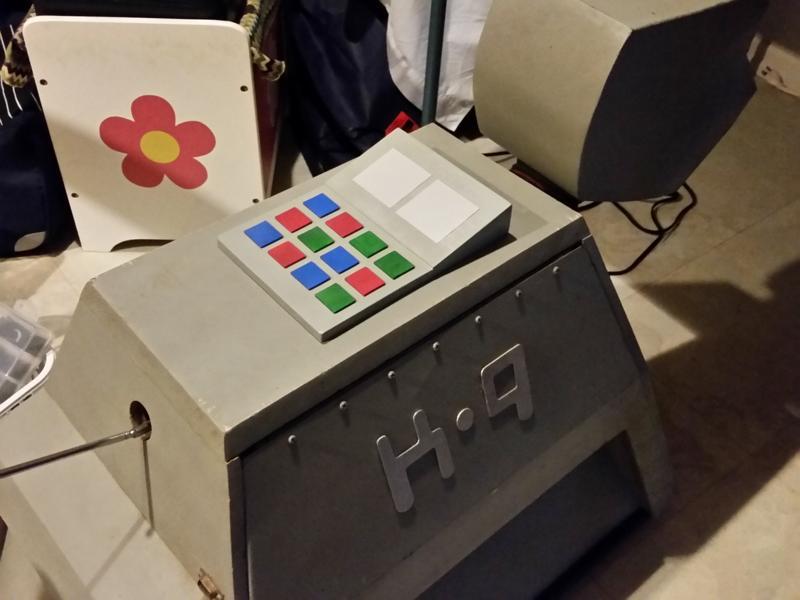
The control panel is now complete. I cut the buttons from a square of peel and stick vinyl tile. You may be wondering how I matched the paint...
Matching the K-9's old "battleship gray" paint for the control panel could
have been difficult. I have another incredible story here.
Toward the end of 1970's, I found about 6 or 7 cans of this spray paint in a
dumpster behind Edward Hines Lumber in Palatine, Illinois.
I shook up a can and tested it, it sprayed ok. So I put the cans in a box and carried it
home.
I used the gray on many projects including K-9. I thought this paint was long
gone. A couple of years ago, I found one remaining spray can at our family
cottage in Wisconsin.
Look at the label, this was old stock from 1968. American Aerosols, Holland
Michigan. Now in 2015, I have 1 can of this 47 year old lacquer spray paint.
And it still works!
9/22/2015
A last minute upgrade before Maker Faire Milwaukee. Replacing the 0.25 watt speaker with a 2.5 watt speaker and class D amp for louder Bluetooth sound.
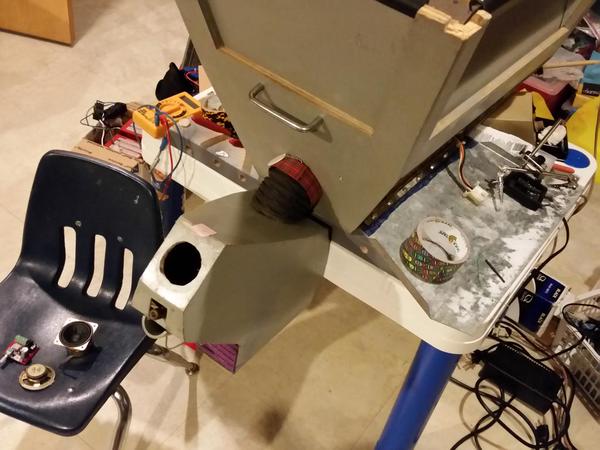
11/10/2015
I recently discovered a snip of old video including my K-9 from 1982. We were at the Chicago Comicon / Panopticon West at the Americana Congress Hotel on Michigan Avenue. KRMA a Denver PBS station was shooting a documentary called "Once Upon A Timelord".
More info and the complete video are available in the Gallifrey Base.
Look for K-9 at 0:55
Other memories of this convention:
http://cuttingsarchive.org/index.php/Dr._Who_materializes_for_Chicago_Convention
http://blogforgallifrey.com/?p=79
more to come....

See my original website from 1995 or earlier here.